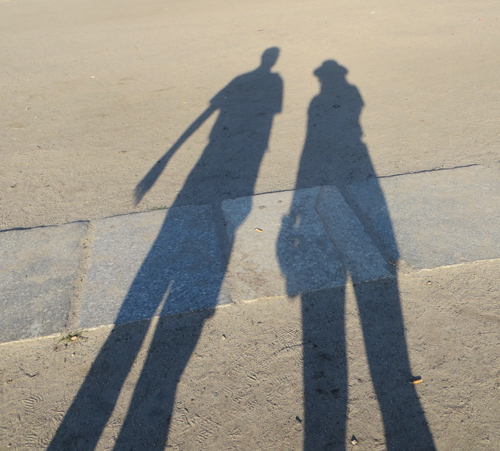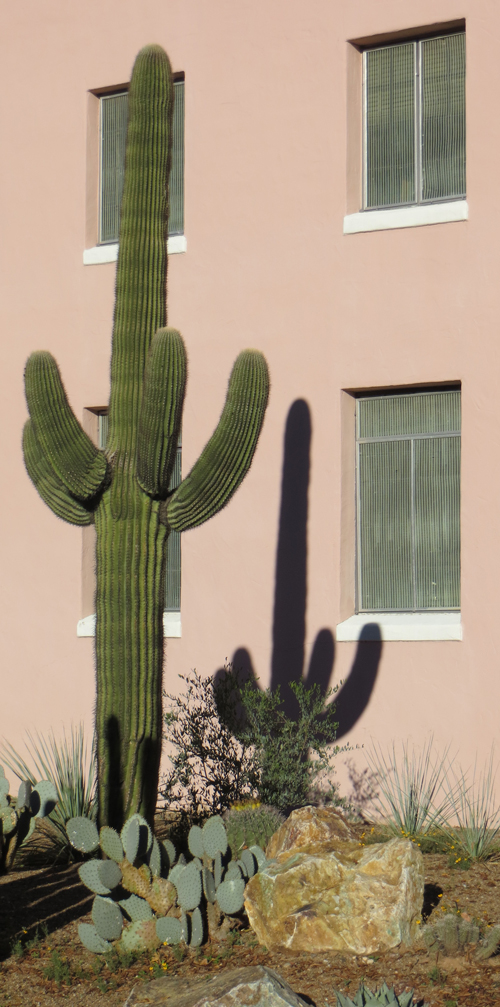Shadow Play
Last night I had the chance to consider a beautiful word:
陰膳 (かげぜん: tray for absent one)
I was doing preliminary research for essay 2049 on 膳 (four-legged tray) and asked my proofreader to explain Breen's somewhat cryptic definition of 陰膳, "tray for absent one."
She obliged, saying that 陰膳 means "preparing food and setting the table in hopes of an absent person’s safe return." It's like a yellow ribbon that symbolizes the hope for the safe return of U.S. troops, she said.
And, I asked, does the first kanji mean "shadow"? It would make sense, I felt. After all, a person's absence casts a long shadow.
Somehow my question amused her, and she emphatically said, "No, no!" As she then explained, this 陰 means “not being able to see something hidden” or “a place where a person isn’t.”
Ah, that's the beautiful part. A place where a person isn't. I doubt we have a compact way of saying that in English.
All the same, I'm not sure that's so far from shadow. After all, a shadow quite visibly marks the place where a person isn't, even though it's adjacent to where that person actually is!

Photo Credit: Eve Kushner
The best picture ever taken of my husband and me.
Shade Versus Shadow
As I thought more about 陰 (かげ), I realized that as much as I love this kanji, it also makes me uneasy. That's because there's something lurking in its shadow! I'm talking about the other かげ kanji, which is 影. They have overlapping meanings, and they even unite in this word:
陰影 (いんえい: shadow)
Now the readings have flipped over to on-yomi.
My discomfort has to do with not knowing how these similar kanji differ. In fact, another proofreader and I had a back-and-forth about this last summer after I defined 陰 as "shadow."
He said that 影 is "shadow" and that 陰 is "shade."
Hmm, I said. Denshi Jisho lists both "shade" and "shadow" as definitions of 陰. Furthermore, Dictionary.com has "shade" and "shadow" as synonyms.
Clearly, given the way they look, those two English words share an etymological root.
And the same must be true in Japanese if both kanji have a kun-yomi of かげ.
Despite all these overlaps, the two kanji are obviously not interchangeable (or else he wouldn't have said what he did), so how exactly do they differ?
Looking at various sources, I have found these definitions, as well as representative words for each shade of meaning:
影 (1017: エイ, かげ: shadow, silhouette)
shadow, silhouette
暗影 (あんえい: shadow, gloom)
影も形もない (かげもかたちもない: nowhere to be seen)
reflected image
影像 (えいぞう: image; shadow; phantom)
人影 (じんえい: human figure; shadow of a person)
撮影 (さつえい: photographing)
light (which is a surprise, but then light is what makes shadows)
月影 (つきかげ or げつえい: moonlight)
星影 (ほしかげ: starlight)
陰 (1013: イン, かげ, かげ•る: shade; gloomy; negative; shadow, secret, negative; yin, sex organs)
gloomy
陰気 (いんき: gloominess), a yomi that's perfect because it sounds like "inky" black!
negative
陰性 (いんせい: negative, dormant)
shade
日陰 (ひかげ: the shade)
behind the scenes
陰で (かげで: behind one's back)
陰口 (かげぐち: backbiting)
So what can we conclude about how these two kanji differ? Yet another proofreader came up with a neat rule of thumb:
• 影: shadow, which is to say a dark shape created on a surface when something stands between a light source and that surface
• 陰: shade, which is to say an area of darkness under or near an object such as a tree, when sunlight does not reach that spot
That is, he pointed out, 影 attaches importance to the shape, whereas 陰 does not. Aha! That's simple!

Photo Credit: Eve Kushner
Shadow of a saguaro. Tucscon, Arizona, December 2014.
The Sound of a Shadow
As much as I love imagining all the things that cast literal shadows, I must say that this abstract word could well be my favorite term containing the shadow kanji:
影響 (えいきょう: influence) shadow + echo
The breakdown is puzzling until you realize that a shadow is to the eyes what an echo is to the ears! Both indicate that the source exists but isn't quite there! It wields an influence from afar. How cool!
I guessed at this, but Daijisen and Daijirin confirm it! Even cooler!
We've been delving into the details of 影 and 陰, and if you're into details (as every kanjiphile undoubtedly is!), check out the newest essay, which is on the detail kanji:

Have a great weekend! And keep an eye out for tomorrow's newsletter!

Comments